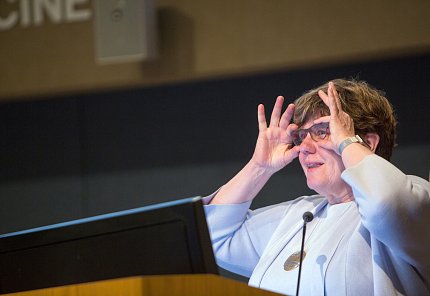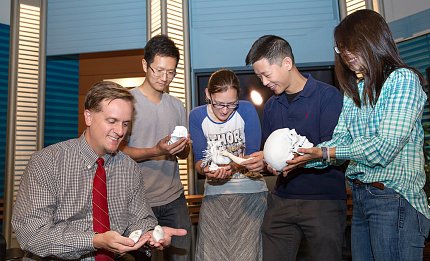Student Visit Busts Myths, Expands Horizons

Photo: Chia-Chi Charlie Chang
The students who came to NIH on June 26 to narrow down their career choices were out of luck. They were introduced to more opportunities than they dreamed possible.
Through presentations, demonstrations, tours, NIH staffers wearing “Ask me about my awesome job” buttons and even a little wizardry, students from Johns Hopkins University’s Center for Talented Youth participated in a day of scientific inquiry designed especially for them.
Cosponsored by NLM and NHGRI, “Genetics, Bioinformatics and Biomedicine” attracted 75 middle and high school students, their parents and the occasional grandparent.

Photo: Chia-Chi Charlie Chang
NLM director Dr. Patricia Flatley Brennan welcomed the students and immediately began busting myths.
She listed three stereotypes about libraries: They’re all about books, being quiet and librarians as nice ladies who wear glasses.
While you can certainly find all of these at NLM—Brennan loves books, likes quiet and is a lady who wears glasses—this day for students wasn’t about any of them. Brennan encouraged the students to make some noise. This was to be a day to get excited about data as a platform for discoveries and pathways for engagement—and much more.
Dr. Terry Yoo from NLM’s Office of High Performance Computing and Communications could relate to the audience in a unique way: His sons had participated in the Hopkins program, so he was prepared to keep the group engaged.
Using props ranging from épées to a plastic building toy to a slide of a yawning bunny, Yoo gave the students a crash course in biomedicine. He borrowed a phrase from President Abraham Lincoln to make the case that data is helping medicine be “of the people, by the people and for the people.”
If a picture is worth a thousand words, the presentations from NLM’s artists could fill a book or two.

Photo: Chia-Chi Charlie Chang
Kristen Browne shared images and examples of the three-dimensional models of body parts that she is creating based on NLM’s Visible Human Project.
Dr. Jeff Day told the audience about his circuitous journey from a kid who loved cartooning and animals to medical doctor to artist at NLM, where he combines many things he enjoys: writing, clinical medicine, public speaking, animation and cartooning.
Donald Bliss talked about his cutting-edge work—calling it “bleeding edge” work—and showed images, including a model of a dendritic cell that looks like it could be a rose.
“Most textbook models of dendritic cells show a cell body with finger-like appendages,” he explained.
Bliss made the case for doing what you love. He said, “Sometimes, I can’t believe I get paid to have this much fun.”
Elizabeth Tuck and the team leading the bioinformatics session from NHGRI set the students up with a simulation to experience how scientists investigate and narrow down a large data set.
She used the real-life example of Nic Volker, a child from Wisconsin who developed a mysterious, life-threatening disease that ravaged his intestines, making it impossible for him to eat normally and causing terrible pain. The students could see for themselves how gene sequencing helped researchers identify a mutation in Volker’s XIAP gene, which led to treatment that saved his life.

Photo: Chia-Chi Charlie Chang
Tuck, a genomics education specialist, also had case studies on other illnesses, including cystic fibrosis and sickle cell disease. She said that students got the satisfaction of solving medical mysteries.
Throughout the day, parents—and students who were interested—took tours of the library, which included information about the architecture of the main library building and views of ancient medical texts.
During lunch, NHGRI and NLM staff mingled with the students so they could answer questions about anything from communicating about asthma to sequencing the genome for Zika.
Afternoon keynote speaker Dr. David Landsman of NLM shared information, fun facts and enthusiasm about his area of expertise and interest: merging results obtained in biology analyses with those derived from experiments in biochemistry, molecular biology, cell biology and genetics.
The senior investigator in the National Center on Biotechnology Information told the audience that there is a large amount of foreign DNA living on and in your body. He went on to explain how humans have bacteria and viruses on their bodies and that bacteria living in the crease of your elbow are different from the ones on your arms. He even rubbed his hands together and blew away some DNA.

Photo: Chia-Chi Charlie Chang
In the Q&A session, he answered questions on everything from basic science to ethics.
In her remarks at the end of the program, Dr. Carla Easter, chief of NHGRI’s Education and Community Involvement Branch, wanted the students to realize that there is “an abundance of opportunities in every aspect of science. One day, maybe one of these students will become a colleague.”
Many students and parents stayed beyond the formal program to check out the NLM exhibition Harry Potter’s World: Renaissance Science, Magic, and Medicine, created in celebration of the 20th anniversary of the Harry Potter series.
Perhaps Prof. Albus Dumbledore’s words of wisdom to Harry Potter in The Chamber of Secrets summed up the day: “It is our choices, Harry, that show what we truly are, far more than our abilities.”
